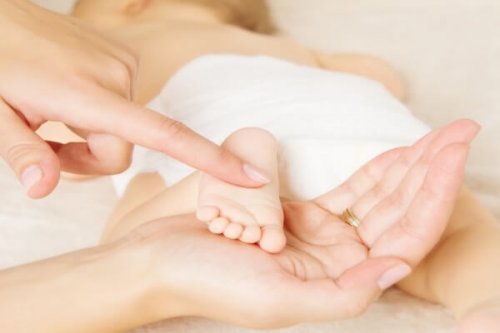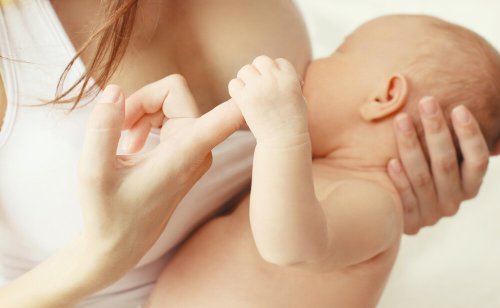Grasp Reflex, What Is It And How To Stimulate it

Have you ever noticed that your baby has an obsession with grabbing everything that you bring towards their hands? This is called the grasp reflex and it’s an indication that their nervous system is working correctly.
During the first week of life, there will come a time when your baby will close their hand to pick up everything that touches or comes close to their palm. This is the grasp reflex. Although at first it’s involuntarily, it will eventually become a controlled action.
Few things give us more butterflies than touching a baby’s soft hands. But it’s even more affectionate when they begin to grab everything within their reach. This is their first interaction with their surroundings. The object of this action can be their fingers, a light toy or your hair.
When they grab your hair, you get to experience the true strength and firmness of the grip caused by the grasp reflex. In fact, when they hold your finger, you can lift them onto their feet on a flat surface and they still won’t let go.
The strange thing about the grasp reflex is that it isn’t exclusive to their hands. You’ll also notice that when something brushes the sole of their feet, their toes will begin to curl as though to catch something.
According to specialists, this is an evolutionary feature. When our ancestors had hair all over their bodies, this action allowed the baby to take hold of their mother in case of danger.

Characteristics of the grasp reflex
Some characteristics include:
- Like all reflexes, it is an involuntary act in response to stimulus. It manifests itself on their hands and feet.
- It occurs during the first and second months of life.
- It’s a signal that indicates their nervous system is functioning correctly.
- In the third month, the grip begins to weaken but they’ll have better movement and control.
- From the fourth month on, their senses are a lot more mature and their actions become intentional and directed, although they’re still unable to calculate distances. From then on, their coordination will continue to develop and they’ll be capable of focusing on a desired object with both hands.
- The grasp reflex lasts a little longer in their feet (between 3-6 months).
How to stimulate the grasp reflex?
In order to stimulate the reflex, there are a few very simple activities you can practice daily. The easiest (not the least effective) is to bring your finger towards your baby’s palm and allow them to grip it.
Meanwhile, the plantar grasp reflex can be stimulated in a similar way. Bring your finger or a pencil towards the bottom of their feet and watch their toes. If they curl them as though to catch the thing that was touching them, then you’re witnessing the classic plantar grasp reflex.
On the other hand, it is also possible to provide early stimulation in order to promote greater mobility and new sensations for your baby.
Everything that involves moving their arms and legs, practicing the use of their senses and even caresses and relaxation exercises can help them to be more conscious of their bodies. This will allow them to get used to new movements.
“In order to stimulate movement in your baby, there are very simple activities that you can practice every day.”
Other great allies for this stage are music and colorful toys with lights, since their senses of hearing and vision are just beginning to awaken.

Other reflexes that are common in babies
In addition to the grasp reflex, there are other reflexes that can be present in the first months of life. Here are a few:
- Moro reflex: it is appreciable immediately after birth. It consists of provoking a jerking movement in the baby. It’s done by gently letting go of their head for a moment (without letting it reach the padded surface below).
- Suction reflex: This can be seen when you touch around the baby’s mouth
- Walking reflex: This is seen when a baby tries to walk as their feet touch a hard surface.
- Galant reflex: When lying face down, stroking or tapping the side of their spine will cause the baby to turn to the direction of where they were touched.
Other reflexes extend until adulthood, such as sneezing, yawning, coughing, nausea and blinking.
All cited sources were thoroughly reviewed by our team to ensure their quality, reliability, currency, and validity. The bibliography of this article was considered reliable and of academic or scientific accuracy.
- Alvarado, G. (2009). Los reflejos primitivos en el diagnóstico clínico de neonatos y lactantes. Revista de Ciencias Clínicas, 9(1), 15-26.
- Lemos, R. (2019, 10 enero). 5 reflejos primitivos en los bebés. Recuperado de https://mejorconsalud.as.com/5-reflejos-primitivos-los-bebes/
This text is provided for informational purposes only and does not replace consultation with a professional. If in doubt, consult your specialist.
